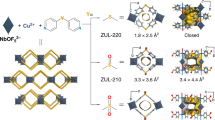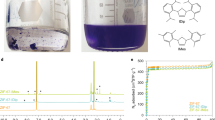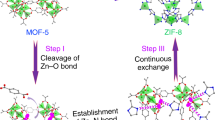Abstract
Formed by linking metals or metal clusters through organic linkers, metal–organic frameworks are a class of solids with structural and chemical properties that mark them out as candidates for many emerging gas storage, separation, catalysis and biomedical applications. Important features of these materials include their high porosity and their flexibility in response to chemical or physical stimuli. Here, a copper-based metal–organic framework has been prepared in which the starting linker (benzene-1,3,5-tricarboxylic acid) undergoes selective monoesterification during synthesis to produce a solid with two different channel systems, lined by hydrophilic and hydrophobic surfaces, respectively. The material reacts differently to gases or vapours of dissimilar chemistry, some stimulating subtle framework flexibility or showing kinetic adsorption effects. Adsorption can be switched between the two channels by judicious choice of the conditions. The monoesterified linker is recoverable in quantitative yield, demonstrating possible uses of metal–organic frameworks in molecular synthetic chemistry as ‘protecting groups’ to accomplish selective transformations that are difficult using standard chemistry techniques.
This is a preview of subscription content, access via your institution
Access options
Subscribe to this journal
Receive 12 print issues and online access
$259.00 per year
only $21.58 per issue
Buy this article
- Purchase on Springer Link
- Instant access to full article PDF
Prices may be subject to local taxes which are calculated during checkout




Similar content being viewed by others
References
Kitagawa, S., Kitaura, R. & Noro, S. Functional porous coordination polymers. Angew. Chem. Int. Ed. 43, 2334–2375 (2004).
Férey, G. Hybrid porous solids: past, present, future. Chem. Soc. Rev. 37, 191–214 (2008).
Yaghi, O. M. et al. Reticular synthesis and the design of new materials. Nature 423, 705–714 (2003).
McKinlay, A. C. et al. BioMOFs: metal–organic frameworks for biological and medical applications. Angew. Chem. Int. Ed. 49, 6260–6266 (2010).
Tranchemontagne, D. J., Mendoza-Cortés, J. L., O'Keeffe, M. & Yaghi, O. M. Secondary building units, nets and bonding in the chemistry of metal–organic frameworks. Chem. Soc. Rev. 38, 1257–1283 (2009).
Wang, Z. & Cohen, S. M. Post synthetic modification of metal–organic frameworks, Chem. Soc. Rev. 38, 1315–1329 (2009).
Kaye, S. S. & Long, J. R. Matrix isolation chemistry in a porous metal–organic framework: photochemical substitutions of N2 and H2 in Zn4O[(η6-1,4-benzenedicarboxylate)Cr(CO)3]3 . J. Am. Chem. Soc. 130, 806–807 (2008).
Hwang, Y. K. et al. Amine grafting on coordinatively unsaturated metal centers of MOFs: consequences for catalysis and metal encapsulation. Angew. Chem. Int. Ed. 47, 4144–4148 (2008).
Chui, S. S. Y., Lo, S. M. F., Charmant, J. P. H., Orpen, A. G. & Williams, I. D. A chemically functionalizable nanoporous material [Cu3(TMA)2(H2O)3]n . Science 283, 1148–1150 (1999).
Férey, G. et al. A hybrid solid with giant pores prepared by a combination of targeted chemistry, simulation, and powder diffraction. Angew. Chem. Int. Ed. 43, 6296–6301 (2004).
Seo, Y. K., Hundal, G., Jang, I. T., Hwang, Y. K., Jun, C. H. & Chang, J. S. Microwave synthesis of hybrid inorganic–organic materials including porous Cu3(BTC)2 from Cu(II)–trimesate mixture. Micro. Mesopor. Mater. 119, 331–337 (2009).
Mueller, U., Schubert, M., Teich, F., Puetter, H., Schierle-Arndt, K. & Pastre, J. Metal–organic frameworks—prospective industrial applications. J. Mater. Chem. 16, 626–636 (2006).
Jiang, Y. et al. Adsorption–desorption induced structural changes of Cu–MOF evidenced by solid state NMR and EPR spectroscopy. J. Am. Chem. Soc. 131, 2058–2059 (2009).
Roosma, J., Mes, T., Leclere, P. Palmans, A. R. A. & Meier, E. W. Supramolecular materials from benzene-1,3,5-tricarboxamide based nanorods. J. Am. Chem. Soc. 130, 1120–1121 (2008).
Wallace, J. U. & Chen, S. H. Simplified scheme for deterministic synthesis of chiral-nematic glassy liquid crystals. Ind. Eng. Chem. Res. 45, 4494–4499 (2006).
Grayson, S. M. & Frechet, J. M. J. Convergent dendrons and dendrimers: from synthesis to applications. Chem. Rev. 101, 3819–3867 (2001).
Greig, L. M. & Philp, D. Applying biological principles to the assembly and selection of synthetic superstructures. Chem. Soc. Rev. 30, 287–302 (2001).
Wang, L. Y., Vysotsky, M. O., Bogdan, A., Bolte, M. & Bohmer, V. Multiple catenanes derived from calix[4] arenes. Science 304, 1312–1314 (2004).
Da Silva, N. et al. A bioinspired approach for controlling accessibility in calix[4] arene-bound metal cluster catalysts. Nature Chem. 2, 1062–1068 (2010).
Kawano, M., Kawamichi, T., Haneda, T., Kojima, T. & Fujita, M. The modular synthesis of functional porous coordination networks. J. Am. Chem. Soc. 129, 15418–15419 (2007).
Llabrés i Xamena, F., Abad, A., Corma, A. & Garcia, H. MOFs as catalysts: activity, reusability and shape-selectivity of a Pd-containing MOF. J. Catal. 250, 294–298 (2007).
Reid, C. R., O'Koye, I. P. & Thomas, K. M. Adsorption of gases on carbon molecular sieves used for air separation. Spherical adsorptives as probes for kinetic selectivity. Langmuir 14, 2415–2425 (1998).
Caskey, S. R., Wong-Foy, A. G. & Matzger, A. J. Dramatic tuning of carbon dioxide uptake via metal substitution in a coordination polymer with cylindrical pores. J. Am. Chem. Soc. 130, 10870–10871 (2008).
Fletcher, A. J. et al. Adsorption dynamics of gases and vapors on the nanoporous metal organic framework material Ni2(4,4′-bipyridine)3(NO3)4: guest modification of host sorption behavior. J. Am. Chem. Soc. 123, 10001–10011 (2001).
Fletcher, A. J., Cussen, E. J., Bradshaw, D., Rosseinsky, M. J. & Thomas, K. M. Adsorption of gases and vapors on nanoporous Ni2(4,4′-bipyridine)3(NO3)4 metal–organic framework materials templated with methanol and ethanol: structural effects in adsorption kinetics. J. Am. Chem. Soc. 126, 9750–9759 (2004).
Kitaura, R., Seki, K., Akiyama, G. & Kitagawa, S. Porous coordination-polymer crystals with gated channels specific for supercritical gases. Angew Chem. Int. Ed. 42, 428–431 (2003).
Klafter, J. & Shlesinger, M. F. On the relationship among 3 theories of relaxation in disordered-systems. Proc. Natl Acad. Sci. USA 83, 848–851 (1986).
Xiao, B. et al. Chemically blockable transformation and ultraselective low pressure gas adsorption in a non-porous metal organic framework. Nature Chem. 1, 289–294 (2009).
Mowbray, M., Tan, X. J., Wheatley, P. S., Morris, R. E. & Weller, R. B. Topically applied nitric oxide induces T-lymphocyte infiltration in human skin, but minimal inflammation. J. Invest. Dermat. 128, 352–360 (2008).
McKinlay, A. C. et al. Exceptional behavior over the whole adsorption–storage–delivery cycle for NO in porous metal organic frameworks. J. Am. Chem. Soc. 130, 10440–10444 (2008).
Xiao, B. et al. High-capacity hydrogen and nitric oxide adsorption and storage in a metal–organic framework. J. Am. Chem. Soc. 129, 1203–1209 (2007).
Bordiga, S. et al. Adsorption properties of HKUST-1 toward hydrogen and other small molecules monitored by IR. PCCP 9, 2676–2685 (2007).
Okoye, I. P., Benham, M. & Thomas, K. M. Adsorption of gases and vapors on carbon molecular sieves. Langmuir 13, 4054–4059 (1997).
Li, J. R., Kuppler, R. J. & Zhou, H. C. Selective gas adsorption and separation in metal–organic frameworks. Chem. Soc. Rev. 38, 1477–1504 (2009).
Zamora, B., Autie, M., Contreras, J. L., Centeno, M. & Reguera, E. Separation of oxygen and nitrogen by porous cyanometallates. Sep. Sci. Technol. 45, 692–699 (2010).
Morris, R. E. & Wheatley, P. S. Gas storage in nanoporous materials Angew. Chem. Int. Ed. 47, 4966–4981 (2008).
Shimomura, S. et al. Selective sorption of oxygen and nitric oxide by an electron-donating flexible porous coordination polymer. Nature Chem. 2, 633–637 (2010).
Ho, T. L. Copper ion-promoted esterifications. Synth. Comm. 19, 2897–2898 (1989).
Acknowledgements
The authors acknowledge funding from the Engineering and Physical Sciences Research Council and the Gas Enabled Medical Innovation (GEMI) fund. R.E.M. is a Royal Society Wolfson Merit Award holder. The authors also thank G. Maurin for calculating the framework charges for the molecular modelling studies.
Author information
Authors and Affiliations
Contributions
M.I.H.M. and R.E.M. conceived and designed the experiments, and M.I.H.M. synthesized the materials. B.X., P.S.W., X.Z., R.G. and K.M.T. completed the adsorption experiments. M.I.H.M., Y.L., A.M.Z.S, D.W.A. and P.S.W. analysed the diffraction experiments. N.F.C. and T.D. completed the molecular modelling, and J.M.G. and S.E.A. the solid-state NMR.
Corresponding author
Ethics declarations
Competing interests
The authors declare no competing financial interests.
Supplementary information
Supplementary information
Supplementary information (PDF 1780 kb)
Supplementary information
Crystallographic data for STAM-1 (CIF 10 kb)
Rights and permissions
About this article
Cite this article
Mohideen, M., Xiao, B., Wheatley, P. et al. Protecting group and switchable pore-discriminating adsorption properties of a hydrophilic–hydrophobic metal–organic framework. Nature Chem 3, 304–310 (2011). https://doi.org/10.1038/nchem.1003
Received:
Accepted:
Published:
Issue Date:
DOI: https://doi.org/10.1038/nchem.1003
This article is cited by
-
Exploring the phase stability in interpenetrated diamondoid covalent organic frameworks
Communications Chemistry (2023)
-
Simultaneous interlayer and intralayer space control in two-dimensional metal−organic frameworks for acetylene/ethylene separation
Nature Communications (2020)
-
Nucleobase pairing and photodimerization in a biologically derived metal-organic framework nanoreactor
Nature Communications (2019)
-
Hydrolytic stability in hemilabile metal–organic frameworks
Nature Chemistry (2018)
-
Sequence-regulated copolymerization based on periodic covalent positioning of monomers along one-dimensional nanochannels
Nature Communications (2018)



